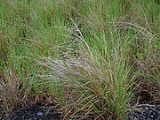
Heteropogon
Encyclopedia
Heteropogon is a small genus of annual
and perennial
grasses
known generally as tangleheads. They are erect tussock grasses found in tropical regions worldwide, and some species grow in warmer temperate areas as well. The inflorescence
s hold paired spikelets. Lower pairs are equal in size (homogamous units), and upper pairs include one awned bisexual
spikelet and one awnless sterile spikelet (heterogamous units). The name of the genus is derived from the Greek
words έτερος (éteros), meaning "different," and πογον (pogon), meaning "beard."
Annual plant
An annual plant is a plant that usually germinates, flowers, and dies in a year or season. True annuals will only live longer than a year if they are prevented from setting seed...
and perennial
Perennial plant
A perennial plant or simply perennial is a plant that lives for more than two years. The term is often used to differentiate a plant from shorter lived annuals and biennials. The term is sometimes misused by commercial gardeners or horticulturalists to describe only herbaceous perennials...
grasses
Poaceae
The Poaceae is a large and nearly ubiquitous family of flowering plants. Members of this family are commonly called grasses, although the term "grass" is also applied to plants that are not in the Poaceae lineage, including the rushes and sedges...
known generally as tangleheads. They are erect tussock grasses found in tropical regions worldwide, and some species grow in warmer temperate areas as well. The inflorescence
Inflorescence
An inflorescence is a group or cluster of flowers arranged on a stem that is composed of a main branch or a complicated arrangement of branches. Strictly, it is the part of the shoot of seed plants where flowers are formed and which is accordingly modified...
s hold paired spikelets. Lower pairs are equal in size (homogamous units), and upper pairs include one awned bisexual
Plant sexuality
Plant sexuality covers the wide variety of sexual reproduction systems found across the plant kingdom. This article describes morphological aspects of sexual reproduction of plants....
spikelet and one awnless sterile spikelet (heterogamous units). The name of the genus is derived from the Greek
Greek language
Greek is an independent branch of the Indo-European family of languages. Native to the southern Balkans, it has the longest documented history of any Indo-European language, spanning 34 centuries of written records. Its writing system has been the Greek alphabet for the majority of its history;...
words έτερος (éteros), meaning "different," and πογον (pogon), meaning "beard."
Selected species
- Heteropogon asiaticus
- Heteropogon contortusHeteropogon contortusHeteropogon contortus is a tropical, perennial tussock grass with a native distribution encompassing Southern Africa, southern Asia, Northern Australia and Oceania. The species has also become a naturalised weed in tropical and subtropical regions in the Americas and East Asia. The plant grows to ...
(L.) P.Beauv.Palisot de BeauvoisAmbroise Marie François Joseph Palisot, Baron de Beauvois 27 July 1752 Arras - 21 January 1820 Paris, was a French naturalist.Palisot collected insects in Oware, Benin, Saint Domingue, and the United States, during the period 1786 – 1797. Trained as a botanist, Palisot published a significant...
ex Roem.Johann Jacob RoemerJohann Jacob Roemer was a physician and professor of botany in Zurich, Switzerland. He was also an entomologist.With Austrian botanist Joseph August Schultes, he published the 16th edition of Carolus Linnaeus' Systema Vegetabilium....
& Schult.Josef August SchultesJosef August Schultes 1773-1831 was an Austrian botanist and professor in Vienna. Together with Johann Jacob Roemer, he published the 16th edition of Linnaeus' Systema Vegetabilium. In 1821, he was elected a foreign member of the Royal Swedish Academy of Sciences.Father of Julius Hermann...
(Pantropical) - Heteropogon fischerianus
- Heteropogon melanocarpus (Elliott) Benth.
- Heteropogon patruelis
- Heteropogon polystachyus
- Heteropogon ritchiei
- Heteropogon triticeus (R.Br.) Stapf ex Craib
Formerly placed here
- Hyparrhenia hirtaHyparrhenia hirtaHyparrhenia hirta is a species of grass known by the common names common thatching grass and Coolatai grass. It is native to much of Africa and Eurasia, and it is known on other continents as an introduced species. In eastern Australia it is a tenacious noxious weed. In South Africa, where it is...
(L.) Stapf (as H. pubescens Andersson) - Trachypogon spicatus (L.f.) Kuntze (as H. secundus J.Presl)

